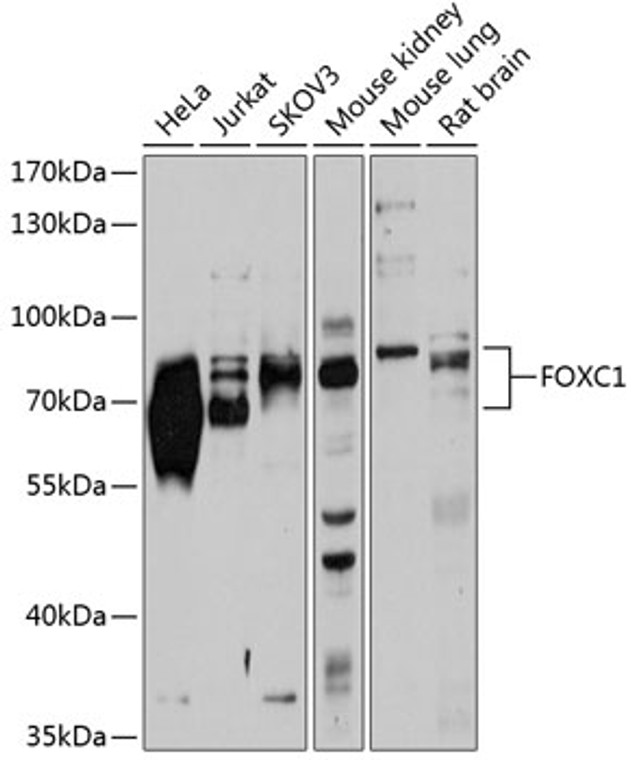| Host: |
Rabbit |
| Applications: |
WB |
| Reactivity: |
Human/Mouse/Rat |
| Note: |
STRICTLY FOR FURTHER SCIENTIFIC RESEARCH USE ONLY (RUO). MUST NOT TO BE USED IN DIAGNOSTIC OR THERAPEUTIC APPLICATIONS. |
| Short Description: |
Rabbit polyclonal antibody anti-FOXC1 (404-553) is suitable for use in Western Blot research applications. |
| Clonality: |
Polyclonal |
| Conjugation: |
Unconjugated |
| Isotype: |
IgG |
| Formulation: |
PBS with 0.02% Sodium Azide, 50% Glycerol, pH7.3. |
| Purification: |
Affinity purification |
| Dilution Range: |
WB 1:100-1:1000 |
| Storage Instruction: |
Store at-20°C for up to 1 year from the date of receipt, and avoid repeat freeze-thaw cycles. |
| Gene Symbol: |
FOXC1 |
| Gene ID: |
2296 |
| Uniprot ID: |
FOXC1_HUMAN |
| Immunogen Region: |
404-553 |
| Immunogen: |
Recombinant fusion protein containing a sequence corresponding to amino acids 404-553 of human FOXC1 (NP_001444.2). |
| Immunogen Sequence: |
AAGERGGHLQGAPGGAGGSA VDDPLPDYSLPPVTSSSSSS LSHGGGGGGGGGGQEAGHHP AAHQGRLTSWYLNQAGGDLG HLASAAAAAAAAGYPGQQQN FHSVREMFESQRIGLNNSPV NGNSSCQMAFPSSQSLYRTS GAFVYDCSKF |
| Tissue Specificity | Expressed in keratinocytes of epidermis and hair follicle. Expressed strongly in microvascular invasion (MVI) formation, basal-like breast cancer (BLBC) and hepatocellular tumors. Expressed in breast cancers (at protein level). Expressed in hematopoietic cells. |
| Post Translational Modifications | Phosphorylated. Phosphorylated on Ser-272 in response to epidermal growth factor (EGF) in a ERK1/2 MAPK-dependent signaling pathway.phosphorylation contributes to its protein stability and transcriptional activity. Sumoylated preferentially with SUMO2 or SUMO3. Desumoylated by SENP2. Ubiquitinated, leading to its proteasomal degradation. |
| Function | DNA-binding transcriptional factor that plays a role in a broad range of cellular and developmental processes such as eye, bones, cardiovascular, kidney and skin development. Acts either as a transcriptional activator or repressor. Binds to the consensus binding site 5'-G/CA/TAAAT/CAAA/C-3' in promoter of target genes. Upon DNA-binding, promotes DNA bending. Acts as a transcriptional coactivator. Stimulates Indian hedgehog (Ihh)-induced target gene expression mediated by the transcription factor GLI2, and hence regulates endochondral ossification. Acts also as a transcriptional coregulator by increasing DNA-binding capacity of GLI2 in breast cancer cells. Regulates FOXO1 through binding to a conserved element, 5'-GTAAACAAA-3' in its promoter region, implicating FOXC1 as an important regulator of cell viability and resistance to oxidative stress in the eye. Cooperates with transcription factor FOXC2 in regulating expression of genes that maintain podocyte integrity. Promotes cell growth inhibition by stopping the cell cycle in the G1 phase through TGFB1-mediated signals. Involved in epithelial-mesenchymal transition (EMT) induction by increasing cell proliferation, migration and invasion. Involved in chemokine CXCL12-induced endothelial cell migration through the control of CXCR4 expression. Plays a role in the gene regulatory network essential for epidermal keratinocyte terminal differentiation. Essential developmental transcriptional factor required for mesoderm-derived tissues, such as the somites, skin, bone and cartilage. Positively regulates CXCL12 and stem cell factor expression in bone marrow mesenchymal progenitor cells, and hence plays a role in the development and maintenance of mesenchymal niches for haematopoietic stem and progenitor cells (HSPC). Plays a role in corneal transparency by preventing both blood vessel and lymphatic vessel growth during embryonic development in a VEGF-dependent manner. Involved in chemokine CXCL12-induced endothelial cell migration through the control of CXCR4 expression. May function as a tumor suppressor. |
| Protein Name | Forkhead Box Protein C1Forkhead-Related Protein Fkhl7Forkhead-Related Transcription Factor 3Freac-3 |
| Database Links | Reactome: R-HSA-9761174 |
| Cellular Localisation | NucleusColocalizes With Pitx2 Isoform 3 In The Nucleus At Subnuclear Chromatine RegionsColocalizes With Cbx5 To A Heterochromatin-Rich Region Of The NucleusColocalizes With Gli2 In The Nucleus |
| Alternative Antibody Names | Anti-Forkhead Box Protein C1 antibodyAnti-Forkhead-Related Protein Fkhl7 antibodyAnti-Forkhead-Related Transcription Factor 3 antibodyAnti-Freac-3 antibodyAnti-FOXC1 antibodyAnti-FKHL7 antibodyAnti-FREAC3 antibody |
Information sourced from Uniprot.org
12 months for antibodies. 6 months for ELISA Kits. Please see website T&Cs for further guidance







